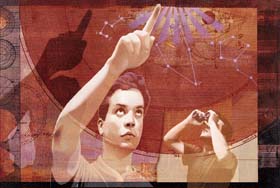| The Boy Scouts of America | http://www.scouting.org |
By Gerald L. Graef
The dying embers of the evening campfire shed a ruddy orange glow as two score eyes watched a small beam of light arise from their midst to move from star to star, outlining constellations. A shaking voice recants tales of adventure, the great bear who chased seven Indian hunters, of Perseus and the head of Medusa.
Introducing a young boy to astronomy is a wonderful opportunity to cultivate a lifelong interest in science. For Scout groups, astronomy is excellent as a stand-alone activity or as a supplement to camp-outs and evening meetings. With a little planning, it is hard to go wrong with astronomy activities.

When I was a boy, nothing evoked my interest in astronomy more than watching one of my teachers, the vice president of a local amateur group, in his backyard: a half-dozen telescopes, no book, no fancy electronics, just moving from telescope to telescope, setting them to a seeming endless parade of sights.
Amateur astronomers like my teacher are the best resources for Scout groups. Many are willing to spend time showing off their hobby and teaching Scouts.
Locate amateur organizations by contacting science museums or planetariums, hobby shops, the science or physics/astronomy department of local colleges or secondary schools. In addition, several national organizations and online networks can help. (See the short address list at the end of this article.)
While a planetarium visit is a good learning activity, the real power of astronomy is best experienced beneath the stars. Before your first venture outside, however, hold a short discussion of basic astronomy. (It's much easier to answer questions when the lights are on.)
If you are new to astronomy, you may want to bring in a local expert to discuss the basics and answer questions. This introductory session need not be long: Just give a basic description of the stars, constellations, and planets. Also explain the seasons and why stars "move."
It's best to begin without telescopes or binoculars. The basic knowledge gained from naked eye astronomy forms the first steps of a ladder that includes binoculars and culminates with telescopes.
Constellations are especially important and are more than the objects of old, fanciful stories--they are the basic elements of the map of the heavens, much as state boundaries on a map of the United States.
After your initial outing, set up a program of activities based on passing the requirements for the Astronomy merit badge.
Astronomy also can be integrated into other events. Camp-outs, in particular, are a natural time to spend a few minutes watching the sky. The evening campfire is great for tales of the origins of the constellations.
Prior to a camp-out, ask Scouts to learn a story to be shared around the campfire or on a star walk. (Most libraries have books on astronomy and the constellations.)
Bring along a strong, tightly focused flashlight to use as a pointer in the sky. On most nights there is enough dust and moisture in the air to make the flashlight beam clearly visible. Be patient with urban Scouts: Familiar constellations will disappear into the vast sea of stars visible in the country.
Evening troop meetings are another good time to stargaze. Just before the meeting adjourns, take a moment to introduce the sky: Point out constellations and planets and note how the stars change positions between meetings. Afterwards, Scouts can update a chart showing the location of the moon, planets, and constellations.
Finally, many advanced projects are possible. Scouts can make simple planispheres, a pair of disks attached in the center and free to rotate. The bottom disk has the constellations drawn on it, and the top disk has a window through which a part of the lower disk is visible.
When held up to the sky, with the upper disk oriented properly, the planisphere shows the location of the constellations at any time of the year. Planispheres can be purchased at many bookstores and, with one as a guide, are easy to duplicate.
Other possible activities include building a troop telescope and charting the brightness of a variable star over a period of a few weeks (charting a variable star is as easy as comparing the brightness of a star to other nearby stars).
Many resources exist for these and other projects. Begin with local amateurs and check out astronomy magazines, Internet sites, and the many books available at stores and libraries.
Most of all, get out under the stars!
Dr. Gerald Graef, an Eagle Scout and a computer programmer, teaches astronomy at the University of Wisconsin-Milwaukee.
Astronomy ResourcesTwo large amateur organizations can help find local groups:
Major online services, such as America Online and CompuServe, have active astronomy groups. In addition, Sky and Telescope magazine maintains a Web site with a list of local planetariums and amateur groups (http://www.skypub.com). Helpful BSA literature includes
|
| The Boy Scouts of America | http://www.scouting.org |